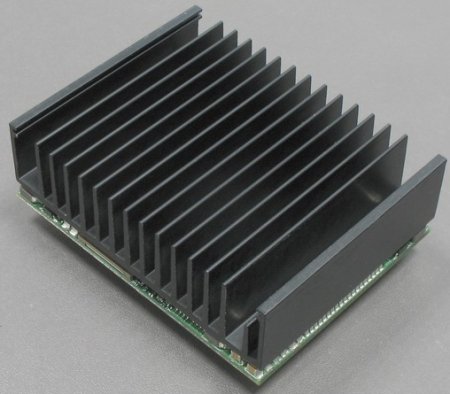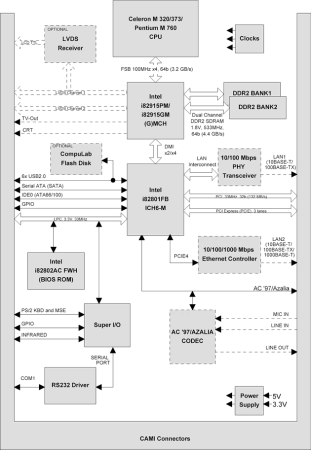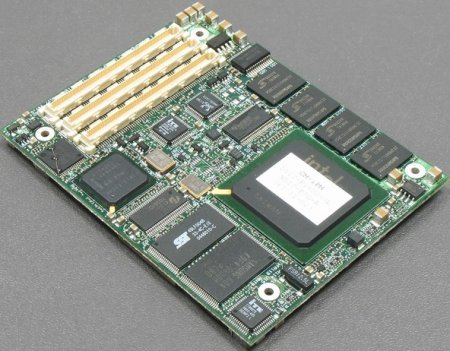Tiny embedded computer module packs Pentium punch
Jan 4, 2007 — by LinuxDevices Staff — from the LinuxDevices Archive — 6 views CompuLab is shipping a tiny embedded computer module available with a Celeron or Pentium M processor clocked at 2GHz. The CM-iPM, which is meant to be used like a component, crams processor, graphics, networking, super-I/O, and PCI Express functions into a 2.75 x 3.5 inch footprint.
CompuLab is shipping a tiny embedded computer module available with a Celeron or Pentium M processor clocked at 2GHz. The CM-iPM, which is meant to be used like a component, crams processor, graphics, networking, super-I/O, and PCI Express functions into a 2.75 x 3.5 inch footprint.
(Click for larger view of CM-iPM module)
At 2.75 x 3.5 inches (70 x 90mm), the CM-iPM is marginally smaller than Kontron's 3.75-inch square (95 x 95mm) MicroETXexpress form-factor. It is also smaller than the 95 x 125mm COM Express standard promoted by Kontron, Intel, and others. And, of course, it is significantly smaller than PC/104 Express, a variant of PC/104 that adds PCI Express.
The CM-iPM is touted as a rugged processor module, with all components soldered on, including memory. Three 140-pin connectors with a pin pitch of 0.6 mm (shown in the photo below) attach the module to custom baseboards. The connectors are rated for 50 insertion/removal cycles, according to CompuLab.
The CM-iPM plugs into other electronics via three 140-pin connectors
The CM-iPM dissipates between 10 and 30 Watts, depending on processor choice and CPU usage, CompuLab says. The module is available in three operating temperature ranges, including an extreme version said to be tested for stability with heatsink temperatures between -72 and 153 degrees F (-40 to 85 C).

CompuLab's “tested” operating temperature ranges are based on heatsink temperatures
(Click to enlarge)
Significant CM-iPM features include support for USB-based NAND flash drives up to 512MB, a PCI Express bus, and optional gigabit Ethernet. The module supports display resolutions up to 1920 x 1200, and offers a plethora of display connection technologies, including LCD, LVDS, CRT, and TV (DVI) interfaces.

CompuLab's CM-iPM module block diagram
(Click to enlarge)
CompuLab lists CM-iPM features and specs as follows:
- Processor options:
- Celeron-M 320/373 from 1.0 GHz
- Pentium-M 760 to 2.0 GHz
- Celeron-M 320/373 from 1.0 GHz
- Chipset — Intel GM915
- Intel i82915PM or i82915GM northbridge
- Intel i82801FB ICH6-M southbridge
- Memory — 256MB to 1024MB DDR2 SDRAM, 400MHz, dual-channel 64-bit
- Display:
- Resolution up to 1920 x 1200
- Frame buffer in system memory
- 2D/3D hardware accelerator
- Many interface options
- LCD — 18-bit TFT (parallel RGB)
- CRT — 24-bit resolution (analog RGB), 250 MHz RAMDAC
- TV — on-board DVI port and encoder, PAL / NTSC
- LVDS — single or dual channel, including 3-pair modes support
- Storage:
- 1 x U-DMA 100/66/33, BMIDE and PIO modes
- 2 x Serial ATA ports
- 128 to 512 Mbyte Flash Disk
- 1 x U-DMA 100/66/33, BMIDE and PIO modes
- I/O ports:
- Optional Ethernet ports, with MAC, PHY, LEDs
- 1st port – 10/100 Mb/s
- 2nd port – 10/100/1000 Mb/s
- 4 or 6 x host USB 2.0 ports, 480 Mbps, EHCI / UHCI compliant
- 1 x serial port, including flow control
- GPIO — 20 lines, shared with other functions. 3.3V-levels, 5V- tolerant
- PS/2 or USB or redirection from serial port
- Infrared up to 115Kbps in SIR mode, 4Mbps in FIR mode
- Audio — CS4202 codec, AC97 interface, mono microphone input, stereo line input and 25 mW output for active speakers
- Optional Ethernet ports, with MAC, PHY, LEDs
- Expansion:
- PCI
- PCI Express
- LPC host bus, 33 MHz, Intel LPC v1.0 compatible
- Dimensions — 2.75 x 3.5 inch (70 x 90mm)
- Power — 3.3V and 5.0V
CompuLab says it provides the CM-iPM with Linux and Windows XP Embedded BSPs (board support packages) capable of running from on-board flash disks.
Availability
The CM-iPM can be configured to order for quantities of 100 units or more. Pricing starts from $250 for a thousand unts.
This article was originally published on LinuxDevices.com and has been donated to the open source community by QuinStreet Inc. Please visit LinuxToday.com for up-to-date news and articles about Linux and open source.
